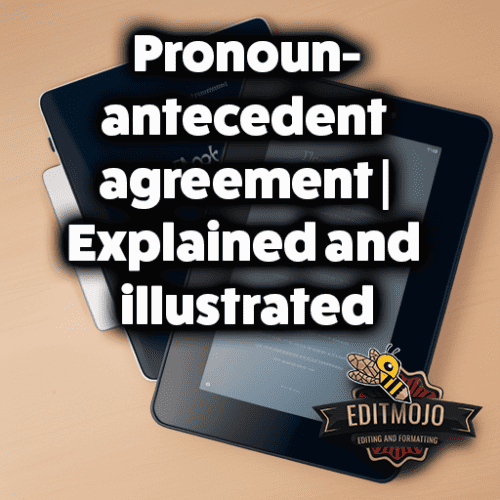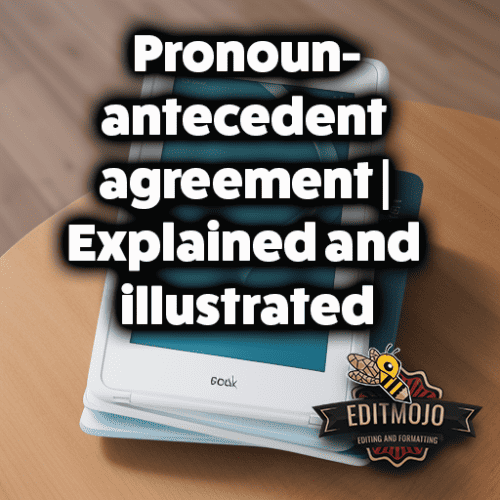Pronoun-antecedent agreement | Explained and illustrated
Pronoun-antecedent agreement | Explained and illustrated. Pronouns and antecedents – two of the numerous building blocks of English grammar that we often use without giving much thought. These fundamentals lay the foundation for clear and effective communication. They hold the power to either clarify your message or turn it into a muddled mess. Understanding pronoun-antecedent agreement is crucial, and as we venture into this fascinating world, you’ll soon grasp why.
Understanding Pronouns and Antecedents (grammar)
What are Pronouns?
Pronouns are linguistic chameleons. They change their form to represent another word, reducing repetition and adding fluidity to language. There are various types, including personal, demonstrative, relative, and interrogative pronouns.
For instance, she is a personal pronoun replacing a woman’s name. Words like this, that, these, those are demonstrative pronouns pointing towards a particular entity or entities. Relative pronouns like who, whom, which connect clauses or phrases, while interrogative pronouns (who, what, where) are used to formulate questions.

What are Antecedents?
The word antecedent derives from Latin roots, meaning “go before.” An antecedent in English grammar is the word or group of words that a pronoun replaces. It’s like a game of hide and seek where the pronoun ‘seeks’ its antecedent ‘hiding’ elsewhere in the sentence.
The Basics of Pronoun-Antecedent Agreement
Agreement is a concept embedded deeply in English grammar. It signifies that different parts of a sentence must ‘agree’ or correspond in certain characteristics like number, gender, or person.
Rules of Pronoun-Antecedent Agreement
Let’s discuss some rules to decode this agreement.
- Singular to Singular, Plural to Plural Rule: A singular antecedent needs a singular pronoun, and a plural antecedent requires a plural pronoun. For instance, “The dog wagged its tail,” not “The dog wagged their tail.”
- Indefinite Pronouns Rule: Indefinite pronouns are usually singular. Words like each, anyone, anybody, neither, either, everyone, somebody are singular. Therefore, the pronouns that refer to them should also be singular. Example: “Everyone should do their homework.” is incorrect. Instead, say “Everyone should do his or her homework.“
- Collective Nouns Rule: Collective nouns (team, class, jury, etc.) are treated as singular unless the context implies otherwise. For instance, “The team has finished its project.” not “The team has finished their project.“
- Gender-specific Rule: The pronoun’s gender should match the antecedent’s gender. Example: “John lost his keys” not “John lost her keys.”

Advanced Concepts in Pronoun-Antecedent Agreement
Grammar, my dear reader, is not always straightforward, and pronoun-antecedent agreement is no exception. Here are some advanced rules to guide you.
Agreement with Compound Antecedents
When antecedents are joined by “and”, use a plural pronoun. For example, “John and Mary have parked their cars.“
But what if they are joined by “or” or “nor”? Use the pronoun that agrees with the nearer antecedent. “Either the man or his children will have to pick up their toys.“
Agreement with Relative Pronouns
Relative pronouns (who, whom, which, that) take the number (and gender) of their antecedents. “I don’t like novels that have unhappy endings.” In this case, that refers back to novels, hence the plural form have is used.
Agreement with Indefinite Pronouns as Antecedents
Here’s where things get tricky. Indefinite pronouns like all, some, none can be singular or plural based on what they refer to. “All of the cake has been eaten.” versus “All of the cakes have been eaten.“

Common Mistakes and Misunderstandings
Even seasoned writers can stumble when it comes to pronoun-antecedent agreement. Mistakes often crop up with indefinite pronouns, collective nouns, and compound antecedents. Here’s a tip: take a moment to clarify what your pronoun is referring to, and ensure they ‘agree’ in number, gender, and person.
The Impact of Pronoun-Antecedent Agreement on Clarity and Readability
Incorrect pronoun-antecedent agreement can leave your readers scratching their heads in confusion. It’s the writing equivalent of a wrong note in a symphony – it stands out and disrupts the flow. In academic or professional writing, such errors can even question your credibility. So, investing time to master these rules is a worthwhile endeavor.
Fun and Effective Ways to Practice Pronoun-Antecedent Agreement
Learning grammar isn’t just about reading rules. You need to practice! Try interactive grammar games, quizzes, or even make your own sentences to test yourself. There’s joy in learning when it’s made fun!
Conclusion (Pronoun-antecedent agreement | Explained and illustrated)
Language is an art and a science. Mastering pronoun-antecedent agreement allows you to be precise and effective, enhancing your communication skills. As Mark Twain once said, “The difference between the almost right word and the right word is … the difference between the lightning bug and the lightning.” So go ahead, harness the lightning of effective language!
References (Pronoun-antecedent agreement | Explained and illustrated)
Here are some resources for further reading:
Happy learning!
| Antecedent | Pronoun | Sentence |
|---|---|---|
| John | He | John ate his lunch because he was hungry. |
| Mary | She | Mary went to her room to get her books. |
| Children | They | The children are playing in their backyard. |
| The cat | It | The cat is eating its food. |
| David and Lisa | They | David and Lisa are eating their dinner. |
| The team | It | The team has won its match. |
| The students | They | The students are preparing for their exam. |
| The dog | It | The dog is wagging its tail. |
| The teacher | She/He | The teacher is marking her/his papers. |
| The birds | They | The birds are in their nest. |
| The computer | It | The computer has lost all of its data. |
| The cars | They | The cars have their headlights on. |
| Susan | She | Susan has lost her keys. |
| The audience | They | The audience is taking their seats. |
| The books | They | The books have lost their covers. |
| The city | It | The city has its charm. |
| The man | He | The man is looking for his hat. |
| The women | They | The women are holding their purses. |
| The company | It | The company has increased its profits. |
| The countries | They | The countries have their own laws. |
In English, pronouns must agree with their antecedents in number (singular or plural) and gender (when applicable). That’s why we use “he” for “John”, “she” for “Mary”, “they” for “David and Lisa”, “it” for “the cat”, and so on.
